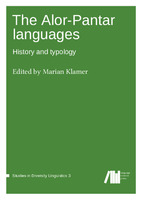The Alor-Pantar languages: History and typology
Author(s)
Klamer, Marian
Collection
Knowledge Unlatched (KU)Language
EnglishAbstract
The Alor-Pantar family constitutes the westernmost outlier group of Papuan (Non-Austronesian) languages. Its twenty or so languages are spoken on
the islands of Alor and Pantar, located just north of Timor, in eastern In-
donesia. Together with the Papuan languages of Timor, they make up the
Timor-Alor-Pantar family. The languages average 5,000 speakers and are
under pressure from the local Malay variety as well as the national lan-
guage, Indonesian.
This volume studies the internal and external linguistic history of this
interesting group, and showcases some of its unique typological features,
such as the preference to index the transitive patient-like argument on
the verb but not the agent-like one; the extreme variety in morphologi-
cal alignment patterns; the use of plural number words; the existence of
quinary numeral systems; the elaborate spatial deictic systems involving
an elevation component; and the great variation exhibited in their kinship
systems.
Unlike many other Papuan languages, Alor-Pantar languages do not ex-
hibit clause-chaining, do not have switch reference systems, never suffix
subject indexes to verbs, do not mark gender, but do encode clusivity in
their pronominal systems. Indeed, apart from a broadly similar head-final
syntactic profile, there is little else that the Alor-Pantar languages share
with Papuan languages spoken in other regions. While all of them show
some traces of contact with Austronesian languages, in general, borrow-
ing from Austronesian has not been intense, and contact with Malay and
Indonesian is a relatively recent phenomenon in most of the Alor-Pantar
region.
Keywords
elevationals; alor-pantar languages; comparative linguistics; papuan languages; typology; linguistics; numeral systems; Abui language; Adang language; Alor–Pantar languages; Blagar language; Parallel and cross cousins; Teiwa language; Wersing language; Western Pantar language; Woisika languageDOI
10.26530/OAPEN_533875ISBN
9783944675480OCN
1030814087Publisher
Language Science PressPublisher website
https://langsci-press.org/Publication date and place
2014Grantor
Classification
Papuan languages
Linguistics


 Download
Download Web Shop
Web Shop